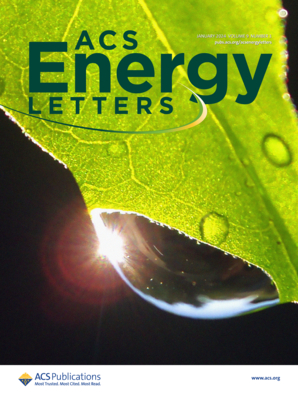Electrochemical CO2 Reduction to Formic Acid with High Carbon Efficiency
IF 18.2
1区 材料科学
Q1 CHEMISTRY, PHYSICAL
引用次数: 0
Abstract
While much of the current research in electrochemical CO2 reduction reaction (CO2RR) identified the CO2 single-pass conversion efficiency (SPCE) as a key performance metric for the technology practical deployment, recently reported high SPCEs in CO2RR are typically at the expense of higher cell voltages or compromised product selectivity. In this work, we use the porous solid electrolyte (PSE) reactor to achieve high CO2 SPCE to high-purity formic acid (HCOOH) while preserving the cell voltage and HCOOH Faradaic efficiency. We successfully recovered the carbon losses in the PSE system to reach a 95.1 ± 1.7% CO2 SPCE to HCOOH at 100 mA cm–2 and demonstrated a stable operation for 100 h. To widen the applicability of the CO2RR technology, we demonstrate a continuous simulated flue gas (10% CO2, 10% O2, balance N2) conversion to high-purity formic acid with CO2 SPCE reaching more than 80% through an electrochemical sequential CO2 capture–CO2 reduction system.

电化学高碳效率CO2还原制甲酸
虽然目前电化学CO2还原反应(CO2RR)的大部分研究都将CO2单次转换效率(SPCE)确定为技术实际部署的关键性能指标,但最近有报道称,CO2RR中的高SPCE通常是以更高的电池电压或降低产物选择性为代价的。在这项工作中,我们使用多孔固体电解质(PSE)反应器实现高CO2 SPCE到高纯度甲酸(HCOOH),同时保持电池电压和HCOOH的法拉第效率。我们成功地回收了PSE系统中的碳损失,在100 mA cm-2下达到95.1±1.7%的CO2对HCOOH的SPCE,并证明了100小时的稳定运行。为了扩大CO2RR技术的适用性,我们演示了通过电化学连续CO2捕获- CO2还原系统将连续模拟烟气(10% CO2, 10% O2,平衡N2)转化为高纯度甲酸,CO2 SPCE达到80%以上。
本文章由计算机程序翻译,如有差异,请以英文原文为准。
求助全文
约1分钟内获得全文
求助全文
来源期刊

ACS Energy Letters
Energy-Renewable Energy, Sustainability and the Environment
CiteScore
31.20
自引率
5.00%
发文量
469
审稿时长
1 months
期刊介绍:
ACS Energy Letters is a monthly journal that publishes papers reporting new scientific advances in energy research. The journal focuses on topics that are of interest to scientists working in the fundamental and applied sciences. Rapid publication is a central criterion for acceptance, and the journal is known for its quick publication times, with an average of 4-6 weeks from submission to web publication in As Soon As Publishable format.
ACS Energy Letters is ranked as the number one journal in the Web of Science Electrochemistry category. It also ranks within the top 10 journals for Physical Chemistry, Energy & Fuels, and Nanoscience & Nanotechnology.
The journal offers several types of articles, including Letters, Energy Express, Perspectives, Reviews, Editorials, Viewpoints and Energy Focus. Additionally, authors have the option to submit videos that summarize or support the information presented in a Perspective or Review article, which can be highlighted on the journal's website. ACS Energy Letters is abstracted and indexed in Chemical Abstracts Service/SciFinder, EBSCO-summon, PubMed, Web of Science, Scopus and Portico.
 求助内容:
求助内容: 应助结果提醒方式:
应助结果提醒方式:


